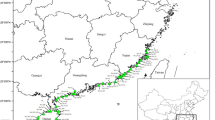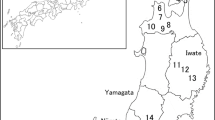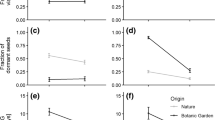Abstract
Farmers and traders have developed a system of names to refer to different qat (Catha edulis) cultivars, using stem color as the primary trait to differentiate them. In this study, we tested if the named cultivars from Ethiopia, Kenya, and Yemen represent genetic clusters. We also quantified clonal reproduction and tracked the geographic dispersal of cultivated–qat genotypes using microsatellite genotypes of specimens collected from across the major qat growing regions (Ethiopia, Kenya, and Yemen). Specimens were mapped to determine whether names, morphology, genetic clusters, or genotypes (in particular clones) were geographically restricted. Stem color was found to be a plastic trait because specimens of the same genotype have different colored stems. A single cultivar name was often applied to numerous clonal groups and genetic clusters, creating widespread homonymy in the ethnotaxonomy of qat cultivars. The East African Rift (EAR) in central Ethiopia was found to be a barrier to the exchange of both clonal groups and certain cultivar names. In Kenya, both cultivar names and clonal groups were broadly dispersed geographically. Nearly all of these clonal groups originated from the Mt. Kenya/Meru area in central Kenya.





Similar content being viewed by others
References
Achtak, H., M. Ater, A. Oukabli, S. Santoni, F. Kjellberg, and B. Khadari. 2010. Traditional agroecosystems as conservatories and incubators of cultivated plant varietal diversity: The case of fig (Ficus carica L.) in Morocco. BMC Plant Biology 10:1471–2229.
Al-Motarreb A., K. Baker, and K. J. Broadly. 2002. Khat: Pharmacological and medical aspects and its social use in Yemen. Phytotherapy Research 16(5):403–413.
Al-Thobhani M. A. 2005. Studies on evaluation of genetic diversity of qat (Catha edulis Forsk.) grown in Yemen. Ph.D. dissertation, University of Agricultural Sciences, Bangalore, India.
Amos, W., J. I. Hoffman, A. Frodsham, L. Zhang, S. Best, and A. V. S. Hill. 2007. Automated binning of microsatellite alleles: Problems and solutions. Molecular Ecology Notes 7:10–14.
Anderson, D., S. Beckerleg, D. Hailu, and A. Klein. 2007. The khat controversy: Stimulating the debate on drugs. Oxford, U.K.: Berg Publishers.
Baudouin, L. and P. Lebrun. 2001. An operational Bayesian approach for the identification of sexually reproduced cross–fertilized populations using molecular markers. Acta Horticulturae 546(5):81–94.
Berlin, B. 1992. Ethnobiological classification: Principles of categorization of plants and animals in traditional societies. Princeton, New Jersey: Princeton University Press.
Berlin, B., D. E. Breedlove, and P. H. Raven. 1974. Principles of Tzeltal plant classification: An introduction to the botanical ethnography of a Mayan speaking community in highland Chiapas. New York: Academic Press.
Bhalla, N. 2002. Ethiopia’s khat dilemma. BBC News. http://news.bbc.co.uk/2/hi/africa/2203489.stm (26 June 2020).
Boster, J. S. 1985. Selection for perceptual distinctiveness: Evidence from Aguaruna cultivars of Manihot esculenta. Economic Botany 39(3):310–325.
Bulcha, M. 1997. The politics of linguistic homogenization in Ethiopia and the conflict over the status of Afaan Oromoo. African Affairs 96:325–352.
Carimi, F., F. Mercati, R. De Michele, M. C. Fiore, P. Riccardi, and F. Sunseri. 2011. Intra–varietal genetic diversity of the grapevine (Vitis vinifera L.) cultivar “Nero d’Avola” as revealed by microsatellite markers. Genetic Resources and Crop Evolution 58:967–975.
Carrier, G., L. L. Cunff, A. Dereeper, D. Legrand, F. Sabot, O. Bouchez, L. Audeguin, J.–M. Boursiquot, and P. This. 2012. Transposable elements are a major cause of somatic polymorphism in Vitis vinifera L., PLoS ONE 7:e32973.
Carrier, N. C. M. 2006. Bundles of choice: variety and the creation and manipulation of Kenyan khat's value. Ethnos 71(3):415–437.
———. 2007 Kenyan khat: the social life of a stimulant. Leiden, Netherlands: Brill Publishers.
Carrier, N. C. M. and L. Gezon. 2009. Khat in the western Indian Ocean. Etudes Océan Indien 42–43:271–297.
Curto, M. A., L. R. Tembrock, P. Puppo, M. Nogueira, M. P. Simmons, and H. Meimberg. 2013. Evaluation of microsatellites of Catha edulis (qat: Celastraceae) identified using pyrosequencing. Biochemical Systematics and Ecology 49:1–9.
Earl, D. A. and B. M. vonHoldt. 2012. STRUCTURE HARVESTER: A website and program for visualizing STRUCTURE output and implementing the Evanno method. Conservation Genetics Resources 4(2):359–361.
England, P. R., G. H. R. Osler, L. M. Woodworth, M. E. Montgomery, D. A. Briscoe, and R. Frankham. 2003. Effects of intense versus diffuse population bottlenecks on microsatellite genetic diversity and evolutionary potential. Conservation Genetics 4(5):595–604.
Evanno, G., S. Regnaut, and J. Goudet. 2005. Detecting the number of clusters of individuals using the software STRUCTURE: A simulation study. Molecular Ecology 14(8):2611–2620.
Fadiman, J. A. 1994. When we began, there were witchmen: An oral history from Mount Kenya. Berkeley: University of California Press.
Felsenstein, J. 1985. Confidence limits on phylogenies: An approach using the bootstrap. Evolution 39(4):783–791.
Gebissa, E. 2004. Leaf of Allah: Khat & agricultural transformation in Harerge, Ethiopia. Oxford, U.K.: James Currey Ltd.
Getahun, A. and A. D. Krikorian. 1973. Chat: Coffee’s rival from Harar, Ethiopia. I. Botany, cultivation and use. Economic Botany 27(4):353–377.
Goldsmith, P. 1988. The production and marketing of miraa in Kenya. In: Satisfying Africa’s food needs: Food production and commercialization in African agriculture, ed., R Cohen, 121–152. Boulder, Colorado: Lynne Rienner Publishers.
———. 1994. Symbiosis and transformation in Kenya’s Meru District. Ph.D. dissertation, University of Florida, Gainesville, Florida.
———. 1999. The political economy of miraa. East African Alternatives 1999 (3):15–19.
Goloboff, P. A. and J. S. Farris. 2001. Methods for quick consensus estimation. Cladistics 17(1):S26–S34.
Google Inc. 2009. Google Earth (5.1.3533.1731) https://www.google.com/earth/ (26 June 2020).
Harlan, J. R. 1992. Crops and man, 2nd edition. Madison, Wisconsin: American Society of Agronomy.
Hill, B. G. 1965. Cat (Catha edulis Forsk). Journal of Ethiopian Studies 3(2):13–23.
Hubisz, M. J., D. Falush, M. Stephens, and J. K. Pritchard. 2009. Inferring weak population structure with the assistance of sample group information. Molecular Ecology Resources 9(5):1322–1332.
Kennedy, J. G. 1987. The flower of paradise: The institutional use of the drug qat in North Yemen. Dordrecht, Holland: D. Reidel Publishing Company.
Kiunga, J., C. Lukhoba, S. Dossaji, and A. Yenesew. 2016. A survey of traditional medicinal uses of Catha edulis (Celastraceae) in Meru and Embu counties of Kenya. International Journal of Ethnobiology & Ethnomedicine 3(1):1–12.
Kopelman, N. M., J. Mayzel, M. Jakobsson, and N. A. Rosenberg. 2015. CLUMPAK: A program for identifying clustering modes and packaging population structure inferences across K. Molecular Ecology Resources 15(5):1179–1191.
Krikorian, A. D. 1985. Growth mode and leaf arrangement in Catha edulis (Kat). Economic Botany 39(4):514–521.
Krizevski, R., E. Bar, N. Dudai, E. Lewinsohn, Y. Sitrit, and S. Ben–Shabat. 2012. Naturally occurring norephedrine oxazolidine derivatives in khat (Catha edulis). Planta Medica 78(8):838–842.
Krizevski, R., N. Dudai, E. Bar, and E. Lewinsohn. 2007. Developmental patterns of phenylpropylamino alkaloids accumulation in khat (Catha edulis, Forsk.). Journal of Ethnopharmacology 114(3):432–438.
Lehmann, T., S. Geisshüsler, and R. Brenneisen. 1990. Rapid TLC identification test for khat (Catha edulis). Forensic Science International 45(1–2):47–51.
Lemessa, D. 2001. Khat (Catha edulis): Botany, distribution, cultivation, usage and economics in Ethiopia. Addis Ababa, Ethiopia: United Nations Development Programme—Emergencies Unit for Ethiopia.
Lewis, P. O. and D. Zaykin. 2001. Genetic data analysis: Computer program for the analysis of allelic data. Version 1.0 (d16c).
Lightbourn, G. J., J. R. Stommel, and R. J. Griesbach. 2007. Epistatic interactions influencing anthocyanin gene expression in Capsicum annuum. Journal of the American Society for Horticultural Science 132(6):824–829.
Martin, G. J. 1995 Ethnobotany: A methods manual. London: Chapman and Hall.
Mbuya, L. P., H. P. Msanga, C. K. Ruffo, A. Birnie, and B. Tengnäs. 1994. Useful trees and shrubs for Tanzania. Nairobi: Swedish International Development Authority.
Meneghetti, S., A. Costacurta, G. Morreale, and A. Calò. 2012. Study of intra–varietal genetic variability in grapevine cultivars by PCR–derived molecular markers and correlations with geographic origins. Molecular Biotechnology 50(1):72–85.
Miller, A. J. and B. L. Gross 2011 From forest to field: Perennial fruit crop domestication. American Journal of Botany 98(9):1389–1414.
Mt. Kenya Star. 2019. “Miraa Cartel”: Faces behind Miraa wars. https://www.standardmedia.co.ke/article/2001330218/the-faces-behind-miraa-wars (14 June 2019).
Muchiri, J. 2018. Embu miraa farmers fight tag of khat variety as bhang https://www.standardmedia.co.ke/article/2001307808/embu-miraa-farmers-fight-tag-of-khat-variety-as-bhang (14 June 2019).
Ngotho, A. 2016. The Miraa politics: Why farmers may not benefit from boom. https://www.the-star.co.ke/news/big-read/2016-05-12-the-miraa-politics-why-farmers-may-not-benefit-from-boom/ (14 June 2019).
Peakall, R. and P. E. Smouse. 2012. GenAlEx 6.5: Genetic analysis in Excel, population genetic software for teaching and research – an update. Bioinformatics 28(19):2537–2539.
Perrier, X., A. Flori, and F. Bonnot. 2003. Data analysis methods. In: Genetic diversity of cultivated tropical plants, eds., P. Hamon, M. Seguin, X. Perrier, and J. C. Glaszmann, 43–76. New York: CRC Press.
Perrier, X. and J. P. Jacquemoud-Collet. 2006. DARwin software http://darwin.cirad.fr/darwin (26 June 2020).
Piry S., A. Alapetite, J.-M. Cornuet, D. Paetkau, L. Baudouin, and A. Estoup. 2004. GENECLASS2: A software for genetic assignment and first–generation migrant detection. Journal of Heredity 95(6):536–539.
Prain, D. 1903. Qât or Arab tea. Indian Planting and Gardening 12:283–284.
Reeves, P. A., C. L. Bowker, C. E. Fettig, L. R. Tembrock, and C. M. Richards. 2016. Effect of error and missing data on population structure inference using microsatellite data. bioRxiv https://doi.org/10.1101/080630. https://www.biorxiv.org/content/biorxiv/early/2016/10/13/080630.full.pdf (26 June 2020).
Revri, R. 1983. Catha edulis Forsk.: Geographical dispersal, botanical, ecological and agronomical aspects with special reference to Yemen Arab Republic. Institut für Pflanzenbau und Tierhygiene in den Tropen und Subtropen. Göttingen, Germany: Universität Göttingen.
Robinson, J. 2006. The Oxford companion to WINE, 3rd edition. Oxford, U.K.: Oxford University Press.
Robson, N. K. B., N. Hallé, N. B. Mathew, and R. Blakelock. 1994. Celastraceae. In: Flora of tropical East Africa, ed., A. Balkema, 1–78. Rotterdam: AA Balkema.
Saitou, N. and M. Nei. 1987. The neighbor–joining method: A new method for reconstructing phylogenetic trees. Molecular Biology and Evolution 4(4):406–425.
Scarcelli, N., M. Couderc, M. N. Baco, J. Egah, and Y. Vigouroux. 2013. Clonal diversity and estimation of relative clone age: Application to agrobiodiversity of yam (Dioscorea rotundata). BMC Plant Biology 13:178–188.
Schopen, A. 1978. Das Qat gesichte und gebrauch des genussmittels Catha edulis Forsk. in der Arabischen Republik Jemen. Wiesbaden, Germany: Franz Steiner Verlag GMBH.
Schorno, X. and E. Steinegger. 1979. CNS–active phenylpropylamines of Catha edulis FORSK. (Celastraceae) of Kenyan origin, Experientia 35(5):572–574.
Shorthouse, D. P. 2010. SimpleMappr, an online tool to produce publication–quality point maps http://www.simplemappr (26 June 2020).
Simmons, M. P. and J. V. Freudenstein. 2011. Spurious 99% bootstrap and jackknife support for unsupported clades. Molecular Phylogenetics and Evolution 61(1):177–191.
Singh, H. 2008. Importance of local names of some useful plants in ethnobotanical study. Indian Journal of Traditional Knowledge 7(2):365–370.
Smouse, P. and R. Peakall. 1999. Spatial autocorrelation analysis of individual multiallele and multilocus genetic structure. Heredity 82:561–573.
Stenberg, P., M. Lundmark, and A. Saura. 2003. MLGsim: A program for detecting clones using a simulation approach. Molecular Ecology Notes 3:329–331.
Szendrei, K. 1980. The chemistry of khat. B Narcotics 32(3):5–35.
Tembrock, L. R., M. P. Simmons, C. M. Richards, P. A. Reeves, A. Reilley, M. A. Curto, H. Meimberg, G. Ngugi, S. Demissew, A. W. Al–Khulaidi, M. Al–Thobhani, S. Simpson, and D. M. Varisco. 2017. Phylogeography of the wild and cultivated stimulant plant qat (Catha edulis, Celastraceae) in areas of historical cultivation. American Journal of Botany 104(4):538–549.
United Nations Narcotics Laboratory. 1975. Studies on the chemical composition of khat: III, Investigations on the phenylalkylamine fraction. Geneva: United Nations Narcotics Laboratory.
Varisco, D. M. 2007. Turning over a new leaf: The impact of qat (Catha edulis) in Yemeni horticulture. In: Botanical progress, horticultural innovation and cultural change, eds., M. Conan and W. J. Kress, 239–258. Washington, D.C.: Dumbarton Oaks Research Library and Collection.
Volk, G. M., A. D. Henk, and C. M. Richards. 2004. Genetic diversity among U.S. garlic clones as detected using AFLP methods. Journal of the American Society for Horticultural Science 129(4):559–569.
Westengen O. T., M. A. Okongo, L. Onek, T. Berg, H. Upadhyaya, S. Birkeland, S. D. K. Khalsa, K. H. Ring, N. C. Stenseth, and A. K. Brysting. 2014. Ethnolinguistic structuring of sorghum genetic diversity in Africa and the role of local seed systems. Proceedings of the National Academy of Sciences USA 111(39):14100–14105.
Wolfes, O. 1930. Über das Vorkommen von d–nor–iso–Ephedrin in Catha edulis. Archiv der Pharmazie 268:81–83.
World Bank. 2007. Yemen, towards qat demand reduction, World Bank document report no. 39738–YE.
Zewde, B. 2001. A history of modern Ethiopia 1855–1991, 2nd edition. Oxford, U.K.: James Currey.
Acknowledgments
We thank Daniel Potter and an anonymous reviewer for numerous suggestions with which to improve the manuscript; Amy Angert, Jennifer Cappa, Todd Gilligan, Daniel Sloan, Sarah Ward, and Jessica Warren for their constructive comments on numerous aspects of this manuscript; Remi Bonnart and Adam Henk for assisting with technical aspects of the experiments; colleagues involved with collecting material for this study, including Wege Abebe, Robert Archer, Tesfaye Awas, Assefa Hailu, Ensermu Kelbessa, Catherine Lukhoba, Geoffrey Mwachala, Pamela Puppo, Helene Razamatsoa, James Solomon, and Melaku Wondafrash; as well as the Ethiopian, Kenyan, Malagasy, and Yemeni farmers who generously allowed us to collect their crops. Funding was provided by the American Institute for Yemeni Studies (to L.R.T.), the Harold David Harrington Fellowship (to L.R.T.), the John Simon Guggenheim Foundation (to M.P.S.), and the National Geographic Society (to M.P.S.). The authors declare that they have no conflict of interest.
Author information
Authors and Affiliations
Corresponding author
Rights and permissions
About this article
Cite this article
Tembrock, L.R., Simmons, M.P., Richards, C.M. et al. Clonal Diversity, Cultivar Traits, Geographic Dispersal, and the Ethnotaxonomy of Cultivated Qat (Catha edulis, Celastraceae). Econ Bot 74, 273–291 (2020). https://doi.org/10.1007/s12231-020-09501-4
Received:
Accepted:
Published:
Issue Date:
DOI: https://doi.org/10.1007/s12231-020-09501-4




